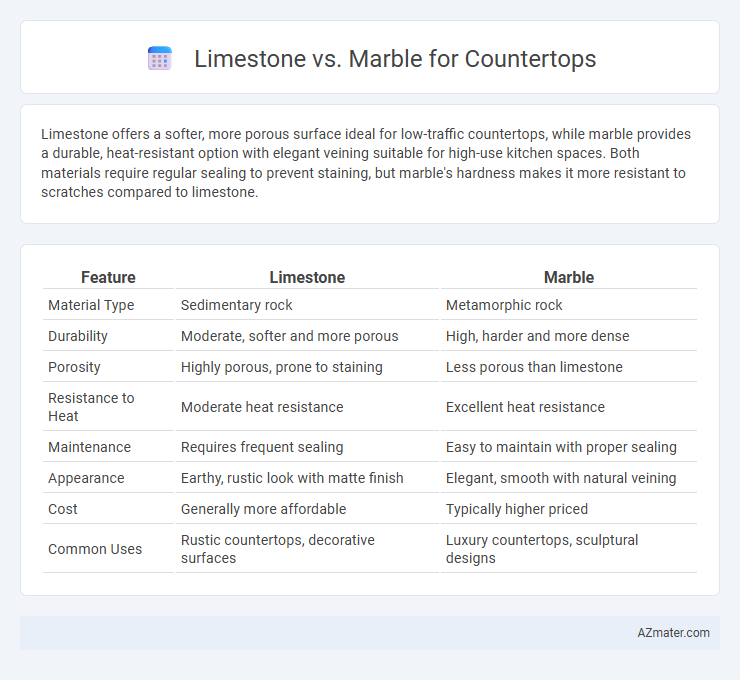Limestone offers a softer, more porous surface ideal for low-traffic countertops, while marble provides a durable, heat-resistant option with elegant veining suitable for high-use kitchen spaces. Both materials require regular sealing to prevent staining, but marble's hardness makes it more resistant to scratches compared to limestone.
Table of Comparison
| Feature | Limestone | Marble |
|---|---|---|
| Material Type | Sedimentary rock | Metamorphic rock |
| Durability | Moderate, softer and more porous | High, harder and more dense |
| Porosity | Highly porous, prone to staining | Less porous than limestone |
| Resistance to Heat | Moderate heat resistance | Excellent heat resistance |
| Maintenance | Requires frequent sealing | Easy to maintain with proper sealing |
| Appearance | Earthy, rustic look with matte finish | Elegant, smooth with natural veining |
| Cost | Generally more affordable | Typically higher priced |
| Common Uses | Rustic countertops, decorative surfaces | Luxury countertops, sculptural designs |
Introduction to Limestone and Marble Countertops
Limestone countertops are composed of sedimentary rock primarily made of calcite, offering a natural, earthy look with porous texture that requires regular sealing to prevent stains. Marble countertops consist of metamorphic rock formed from recrystallized carbonate minerals, noted for their elegant veining and smooth surface, making them a popular choice for high-end kitchens. Both materials offer unique aesthetic appeal, but differ in durability and maintenance needs, influencing their suitability for various countertop applications.
Composition and Formation Differences
Limestone, composed primarily of calcite derived from marine organisms, forms through sedimentation under low heat and pressure, resulting in a softer, more porous material. Marble originates from limestone that undergoes metamorphism, where intense heat and pressure recrystallize the calcite to produce a denser, harder surface with distinct veining patterns. These composition and formation differences impact durability, maintenance, and aesthetic qualities, making marble more resistant and visually dynamic compared to the more susceptible and uniform limestone.
Appearance and Aesthetic Qualities
Limestone countertops showcase a soft, matte finish with subtle earthy tones and natural fossil patterns, creating a warm, rustic aesthetic ideal for traditional or Mediterranean-style kitchens. Marble boasts a polished, glossy surface with dramatic veining in colors ranging from white and gray to green and pink, delivering a luxurious and timeless elegance popular in classic and contemporary designs. Both materials develop a unique patina over time, but marble's high contrast veining provides a more striking visual impact compared to limestone's understated, uniform appearance.
Durability and Hardness Comparison
Limestone countertops have a Mohs hardness of around 3 to 4, making them softer and more prone to scratches and etching compared to marble, which ranges from 3 to 5 but can be denser depending on the type. Marble, a metamorphic rock primarily composed of recrystallized calcite, generally offers greater durability and resistance to heat and impact than limestone, a sedimentary rock formed from compacted calcium carbonate. Both materials require regular sealing to prevent staining, but marble's denser structure provides superior long-term resilience in kitchen applications.
Maintenance Requirements
Limestone countertops demand regular sealing and gentle cleaning to prevent staining and etching due to their porous nature. Marble, while offering a durable surface, requires similarly frequent sealing and prompt spill management to maintain its polished appearance and prevent acid damage. Both materials benefit from avoiding harsh chemicals and abrasive cleaners to preserve their natural beauty over time.
Stain and Scratch Resistance
Limestone countertops exhibit moderate stain resistance but are highly prone to etching and scratches due to their porous, softer nature; sealing can help reduce staining yet frequent maintenance is required. Marble surfaces, composed of calcite, offer better scratch resistance than limestone but remain vulnerable to acidic stains and etching, necessitating proper sealing and careful use. Both materials demand diligent upkeep to maintain appearance, with marble generally favored for its enhanced durability and elegance in countertop applications.
Cost and Affordability
Limestone countertops generally cost between $40 and $75 per square foot, making them a more affordable option compared to marble, which ranges from $50 to $150 per square foot depending on quality and origin. Marble's higher price reflects its premium aesthetic and durability but requires more maintenance, potentially increasing long-term costs. Choosing limestone offers budget-conscious homeowners a natural and stylish surface while maintaining lower upfront expenses.
Installation Considerations
Limestone countertops require careful sealing and regular maintenance due to their porous nature, making installation sensitive to moisture exposure and staining risks. Marble offers greater durability but demands precise cutting and handling to prevent chipping and cracking during installation. Both materials need professional assessment for substrate strength to support their weight and ensure long-term stability.
Best Applications for Each Material
Limestone countertops excel in low-traffic areas like bathrooms and decorative accents due to their softer, porous nature which requires regular sealing to prevent staining and etching. Marble countertops are ideal for kitchens and high-end bathroom vanities because of their heat resistance and elegant veining, although they also need maintenance to preserve their polished surface. Both materials offer unique natural beauty but differ in durability, making marble better suited for heavy-use applications and limestone best for aesthetic, low-maintenance use.
Conclusion: Choosing the Right Countertop Material
Limestone offers a natural, porous surface with a warm, matte finish ideal for low-traffic areas, while marble provides a luxurious, durable option with unique veining patterns suitable for high-visibility spaces. Consider maintenance requirements, as limestone is softer and more prone to etching and staining compared to the harder, more resilient marble. Selecting the right countertop material depends on balancing aesthetic preferences, durability needs, and upkeep commitment to ensure lasting beauty and functionality.

Infographic: Limestone vs Marble for Countertop
 azmater.com
azmater.com